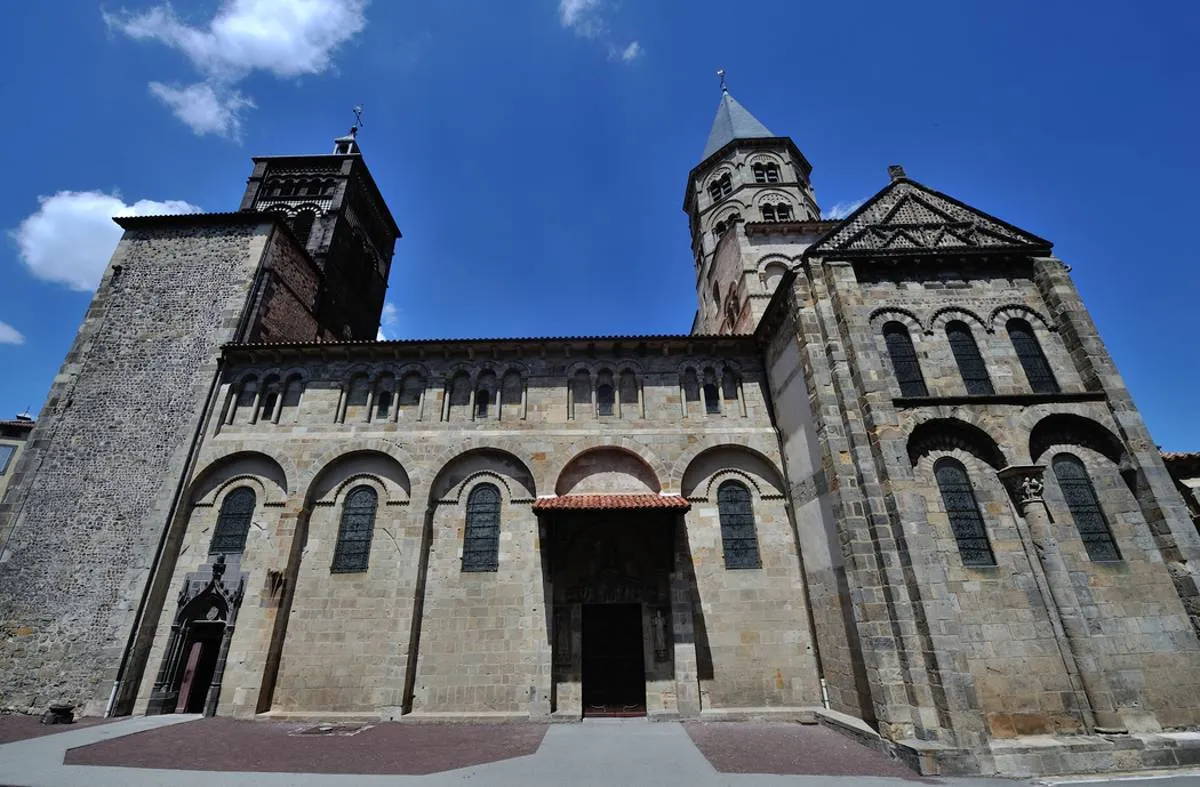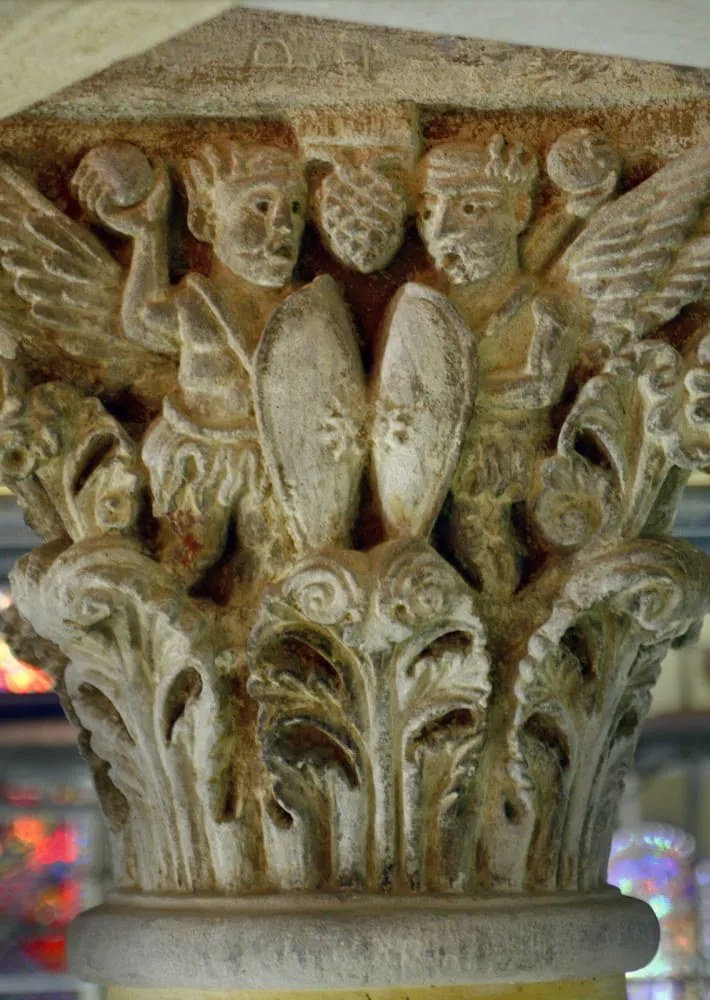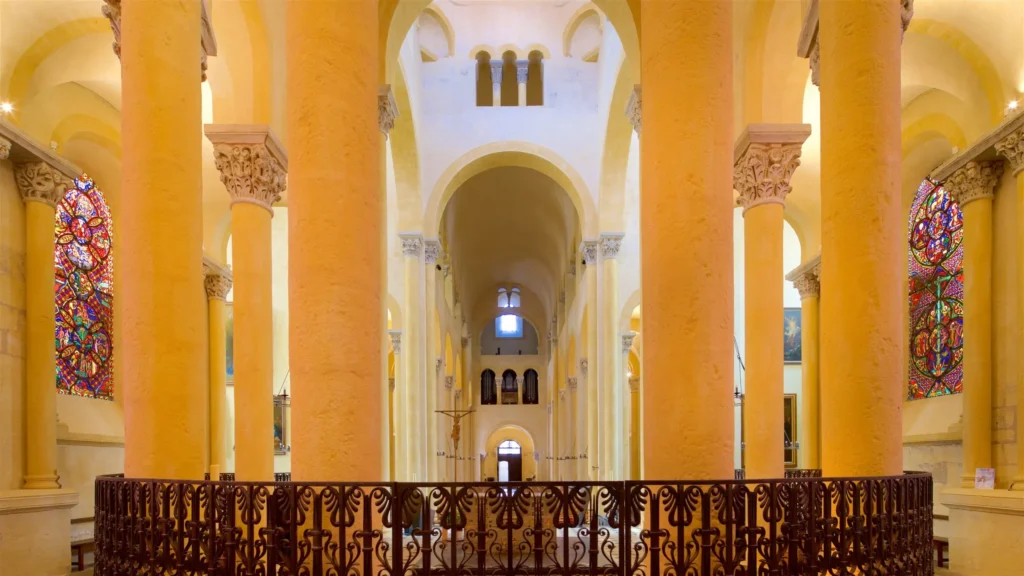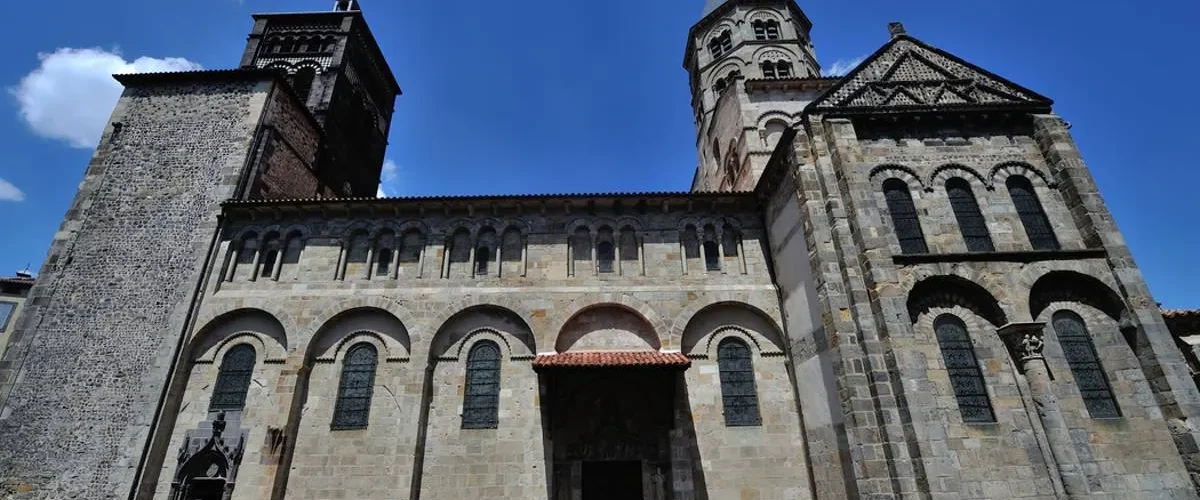Introduction

The Basilica of Notre-Dame du Port is a Romanesque basilica, formerly a collegiate church, in the Port quarter of Clermont-Ferrand, between Place Delille and the cathedral. From the 10th century to the French Revolution it was served by a community of canons, regular until the 13th century, and thereafter secular. Notre-Dame-du-Port Basilica is situated in the Quartier du Port of Clermont-Ferrand. It is one out of the ten ‘Major’ Romanesque churches of Basse-Auvergne, all clustered within a 30-kilometer radius of the city.

According to tradition, the church was founded by the Bishop of Clermont, Avitus of Clermont, in the 6th century and was rebuilt in the 11th or 12th century after being burned down by the Normans. The establishment here of a community of canons took place no earlier than the middle of the 10th century, under bishop Étienne II of Clermont. The church was formally declared a basilica minor on 3 May 1886.
In the 19th century the bell tower was added, and the Romanesque roof tiles were replaced by lava slabs. These have since been removed again and the roof restored as near as possible to its original state. A major restoration programme took place in the church interior between 2007 and 2008, consisting of the cleaning of all the stonework, the removal of cement pointing from the restoration of the 19th century, the restoration of the pictures and the replacement of the lustres (the crypt however was not included).
On Sunday 7 December 2008 the statue of Notre-Dame du Port (“Our Lady of the Port”) was reinstalled in the church, having been kept safe in Clermont Cathedral during the restoration works, thus marking the reopening of the building to the public. In 1998 the Basilica of Notre-Dame du Port was added to the UNESCO World Heritage list as part of the Routes of Santiago de Compostela in France.
The name “du Port” supposedly comes from the fact that the church was built in the “port” district, in Latin portus, here in the sense of “market” rather than “seaport”. The church at first bore the name of Sainte-Marie-Principale; the description Portus or du Port is not known before the 11th century. Nor was the Port district, at least in the Middle Ages, a particularly commercial one: the districts of Saint-Pierre and Saint-Genès were much more so.

Formerly a collegiate church, in the Port quarter of Clermont-Ferrand. From the 10th century to the French Revolution it was served by a community of canons, regular until the 13th century, and thereafter secular. The basilica is one of the five Romanesque churches in Auvergne known as the “greater” churches (majeures). According to tradition, the church was founded by the bishop of Clermont, Saint Avitus, in the 6th century and was rebuilt in the 11th or 12th centuries after being burned down by the Normans. The apse and chevet are richly decorated with mosaics and carving. The capitals, which are among the finest in Auvergne, principally depict scenes from the Bible, but also some from the Psychomachia of Prudentius.
Notre-Dame-du-Port Basilica founded by St. Avitus
Founded by Saint Avitus, the 18th bishop of Clermont, in the 6th century AD, the church endured the ravages of Norman invasions during the 9th century. However, it was not until the 11th and 12th centuries that the church was reconstructed, with local sandstone, known as arkose blonde, crafted by skilled stonemasons.
Unfortunately, earthquakes in the 15th century caused significant damage to the structure. Situated in the region of the ancient volcanoes of Auvergne, Notre-Dame-du-Port Basilica has weathered both natural and man-made challenges throughout its history.
Initially served by a community of canons, who were replaced by secular clergy after the 13th century, the basilica witnessed changes over the centuries, including alterations to its bell tower during the 19th century. However, these renovations obscured many of the original architectural elements.
In 2007-2008, an extensive restoration project was undertaken to return the church to its early 1900s appearance. During this period, the statue of Notre-Dame-du-Port was temporarily relocated to the cathedral. Upon the completion of the restoration on Sunday, December 7, 2008, the statue was reverently returned to its rightful place in the basilica.
A Masterpiece of Auvergne Romanesque Architecture
Notre-Dame-du-Port Basilica stands as a true masterpiece of Auvergne Romanesque architecture, and was built on a Latin cross basilica layout. Its interior is a marvel of diversity, highlighted by the intricate decoration and the presence of four radiant chapels opening onto the ambulatory.
The intricately carved capitals, widely regarded as some of the finest in the Auvergne region, depict scenes from the Bible, including the expulsion of Adam and Eve from Paradise. One captivating capital portrays an angel gripping Adam by his beard, while Adam, feeling he’s not alone in guilt, is depicted pulling Eve’s hair.
Another prominent theme in the sculptures is the eternal struggle between vices, such as greed, and virtues like generosity and charity. The tympanum, equally striking, features Christ in Majesty, surrounded by the four evangelists and two angels with multiple pairs of wings.
Under the protective gaze of Our Lady of the Port, Notre-Dame-du-Port Basilica houses a small Black Virgin statue in La Souterraine, the crypt nestled beneath the chancel, adding to the site’s spiritual significance and historical richness.
Description
The Basilica is one of the five Romanesque churches in Auvergne known as the “greater” churches (majeures), the others being the church of Saint-Austremoine in Issoire, the Basilica of Notre-Dame of Orcival, the church of Saint-Nectaire, and the church of Saint-Saturnin.
Built of arkose, a sort of sandstone, the building has an almost perfect harmony supposedly resulting from the application of the ratio of the Golden Number. The church is built on a Latin cross ground plan with a nave of six bays between two low side aisles with simple vaults. There is a transept with a semi-circular chapel on each arm, and a quire surrounded by an ambulatory from which open four radiating chapel, none of them on the main axis, thus forming a chevet, which with its fine mosaics is a notable example of the Romanesque art of Auvergne. The capitals, which are among the finest in Auvergne, principally depict scenes from the Bible, but also some from the Psychomachia of Prudentius.
Feast Day
Marian Novena in May and Feast of Our Lady of the Port
As Every year, a Marian Novena takes place with daily mass, a concert and a conference, a pilgrimage for people who are sick or have reduced mobility, and a night of adoration with young people.
On the closing Sunday [first Sunday after May 15], there is the pontifical mass followed in the afternoon by a procession through the streets of the city.
Church Mass Timing
Celebration of the Feasts of the Virgin Mary
For all the Feasts of Mary Mass Timing
With some exceptions, mass is celebrated at 6:30 p.m. in the Notre-Dame du Port basilica, preceded by the Marian prayer at 5:45 p.m. in the crypt.
Sunday and Solemn Day
Mass at 9:00 a.m. (with the Portuguese community)
Mass at 11:00 a.m.
Church Opening Time:
Monday : 9.00 AM – 6.00 PM
Tuesday : 9.00 AM – 6.00 PM
Wednesday : 9.00 AM– 6.00 PM
Thursday : 9.00 AM – 6.00 PM
Friday : 9.00 AM – 6.00 PM
Saturday : 9.00 AM – 6.00 PM
Sunday : 9.00 AM – 6.00 PM
Contact Info
Address:
4 Rue Notre Dame du Port,
63000 Clermont-Ferrand, France
Phone : +33 4 73 29 29 70
Accommodations
Connectivities
Airway
Clermont-Ferrand Auvergne Airport to Basilica of Notre-Dame du Port, France
Distance 17 min (6.5 km) via D54
Railway
Clermont-Ferrand railway Station to Basilica of Notre-Dame du Port, France Distance 8 min (2.2 km) via Chau. Claudius








